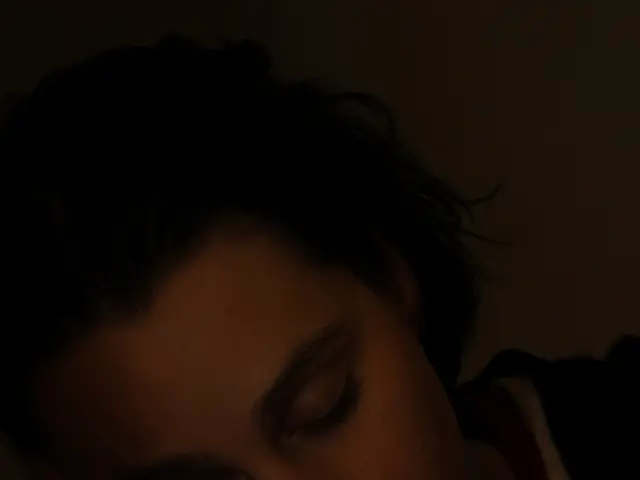Resting Pillow-Free: Reason, Advantages, and Tips for Avoiding Pillows During Sleep
Snoozing Without a Cushion: Is It Worth It or Will It Cause Problems?
Listen up if you've ever pondered whether it's bad to skip out on a pillow while you catch some Z's. Here's a lowdown on the well-being implications of snoozing minus a pillow.
The Role of Pillows for Dreamland Drift
Why do people use a pillow for a cozy slumber time? Pillows serve two main purposes—they help maintain proper neck and upper back alignment, and they provide the support needed for optimal sleep posture [1].
Here are some key advantages of rolling your head on a pillow:- Improved comfort levels- Proper body alignment- Decreased neck and shoulder discomfort- Better sleep quality
A Soft or Firm Landing? Choosing to Skip the Pillow
For certain slumber enthusiasts, knocking out without a pillow might be a superior call compared to snoozing with one. According to research, a pillow can't guarantee a high-quality rest every time. Poor pillow support, height, and quality may lead to terrible sleep, as discovered in studies [2].
Ditching the cushion can do wonders for spinal alignment, enhance blood flow, minimize the risk of wrinkles, boost respiration, and allow the neck to rest in a more neutral position.
The Downsides of Life Without a Pillow
However, embracing a pillow-free lifestyle is not all roses. Snoozing on a hard surface offers some drawbacks that may give you pause.
Louder Sleeping
One major issue when shunning a pillow is that it can make your snoring even more unbearable. Snoring usually happens due to the narrowing and partial obstruction of the airway. By not propping up your head, you increase the likelihood of airway narrowing, which can worsen snoring symptoms, even for those with sleep apnea [3].
Increased Pressure Points
Sleeping entirely sans cushion can put more pressure on specific body parts, such as the head, shoulders, and back. This heightened pressure may result in neck pain, joint pain, or overall stiffness upon waking [4].
It's usually advised for those vulnerable to pain and stiffness to keep using a pillow, as it can evenly distribute weight and reduce the likelihood of waking up with aches and pains.
An Uncomfortable Voyage
Lastly, consider the simple fact that not everyone can get comfortable lying on a hard surface. While some may find it beneficial for their posture, others may find it extremely uncomfortable.
Ultimately, it comes down to your personal preference and what you find comfortable.
Tips for Cozying Up Without a Pillow
If you're feeling adventurous and want to try snoozing without a pillow, here are some pointers to help you make a smooth transition.
Gradual Evolution
If you've been using a pillow for a long time and plan on making a switch, it's best to transition slowly. Quitting the pillow cold turkey may cause discomfort, making it harder for you to stick with your new habit.
Start with a thin pillow or a soft one so that you can slowly get used to this reduced elevation. Incrementally reduce the pillow thickness over time to find a level of comfort that suits your needs.
The Right Sleep Position
Your sleep position may determine whether you're suitable to snooze with no pillows. It's not recommended for back or side sleepers, as it can lead to potential health issues, such as neck and back pain.
On the other hand, stomach sleepers may find lying on a flat surface a good option for keeping their neck aligned and minimizing strain.
Support Your Body
Consider using some form of support for the rest of your body if you don't intend on using any for your head and neck. You can do this by opting to use a small towel or pillow between your legs, under your knees, or your hips, depending on your sleep position.
This support can help alleviate strain on your lower back.
Finding the Right Mattress
The right mattress also plays a part in helping you adjust to a pillow-free sleep experience. Experiment with different mattresses to find the one that feels comfortable while aligning your spine.
Check out this Hybrid Mattress Guide for some insights.
Keep Monitoring Your Comfort
Always keep an eye on how you feel. If you're waking up with pain or discomfort, it might be time to re-evaluate your current sleep position or consider using a folded blanket or switching back to using a pillow until you feel more comfortable.
By following these tips, you may make your transition into a new pillow-free sleep routine a smooth one without negatively impacting your sleep quality.
Selecting the Right Pillow for Different Sleepers
Even if you're not ready to part ways with your pillow, it's essential to know what type is best for your sleep position to avoid potential sleep interruptions.
These are the pillows that you should use based on your sleep style:
Stomach Sleepers
Stomach sleeping is generally considered the least healthy sleep position, whether it's with a pillow or without. To lessen the risk of back pain and spinal issues for stomach sleepers, it's best to opt for pillows that are soft, low-loft, and breathable. Down pillows or feather pillows work well.
Side Sleepers
For side sleepers, selecting a pillow that keeps both the spine aligned and the upper body adequately supported is essential. As such, they should consider using a firm pillow with a high loft that offers enough thickness.
Memory foam pillows or body pillows may be suitable options for side sleepers.
Back Sleepers
For back sleepers, maintaining the natural neck curvature while providing the proper support is vital. Memory foam pillows, contour pillows, or down pillows with medium firmness and medium loft may be the best choices for back sleepers.
Wrapping Up
In conclusion, whether you prefer snoozing with or without a pillow is largely a personal choice, depending on your sleep position, health issues, and overall comfort level. Skipping out on a pillow requires you to weigh the pros and cons and learn strategies for making a transition without worsening your sleep quality.
If you're finding it challenging to get enough quality sleep, check out the ShutEye® App. ShutEye® is a top-notch sleep-tracking app designed to monitor your sleep cycle and offer advice on sleep optimization. Give it a try today for FREE!
- Utilizing a sleep mask instead of a pillow during sleep can potentially alleviate issues related to insomnia, as it helps block out light, promoting a darker environment for better sleep.
- For individuals with sleep apnea, skipping a pillow in favor of a hard surface might exacerbate symptoms, as it can increase the chances of airway narrowing and worsen snoring.
- In the realm of health-and-wellness, science suggests that the choice between a pillow and a sleep mask for sleep might depend on various factors, including sleep position, personal comfort, and any underlying health conditions such as sleep apnea.








